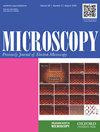Advances in ultrahigh-energy resolution EELS: phonons, infrared plasmons and strongly coupled modes.
IF 1.5
4区 工程技术
Q3 MICROSCOPY
引用次数: 16
Abstract
Nowadays, sub-50 meV atom-wide electron probes are routinely produced for electron energy loss spectroscopy in transmission electron microscopes due to monochromator technology advances. We review how gradual improvements in energy resolution enabled the study of very low-energy excitations such as lattice phonons, molecular vibrations, infrared plasmons and strongly coupled hybrid modes in nanomaterials. Starting with the theoretical framework needed to treat inelastic electron scattering from phonons in solids, we illustrate contributions in detecting optical surface phonons in photonic structures. We discuss phonon mapping capabilities in real and reciprocal space, and the localized phonon response near nano-/atomic-scale structural features. We also survey the progress of aloof spectroscopy in studying vibrations in organic materials and applications in measuring local temperature and photonic density of states in single nanostructures using phonon scattering. We then turn towards studies on infrared plasmons in metals and semiconductors. Spectroscopy analyses now extend towards probing extremely complex broadband platforms, the effects of defects and nanogaps, and some far-reaching investigations towards uncovering plasmon lifetime and 3D photonic density of states. In doped semiconductors, we review research on the use of the electron probe to correlate local doping concentration and atomic-scale defects with the plasmonic response. Finally, we discuss advances in studying strong coupling phenomena in plasmon-exciton and plasmon-phonon systems. Overall, the wealth of information gained extends our knowledge about nanomaterial properties and elementary excitations, illustrating the powerful capabilities of high-energy resolution scanning transmission electron microscopy-electron energy loss spectrometry.超高能量分辨率EELS的进展:声子、红外等离子体激元和强耦合模式。
目前,由于单色技术的进步,在透射电子显微镜中,常规生产了50 meV以下的原子范围的电子探针,用于电子能量损失光谱。我们回顾了能量分辨率的逐步提高如何使晶格声子、分子振动、红外等离子体和纳米材料中的强耦合杂化模式等极低能量激发的研究成为可能。从处理固体中声子的非弹性电子散射所需的理论框架开始,我们说明了在探测光子结构中的光学表面声子方面的贡献。我们讨论了声子在实空间和互反空间中的映射能力,以及纳米/原子尺度结构特征附近的局域声子响应。综述了超然光谱学在有机材料振动研究中的进展,以及利用声子散射测量单纳米结构局部温度和态光子密度的应用。然后我们转向研究金属和半导体中的红外等离子体。光谱学分析现在扩展到探测极其复杂的宽带平台,缺陷和纳米间隙的影响,以及一些对揭示等离子体寿命和三维光子密度状态的深远研究。在掺杂半导体中,我们回顾了利用电子探针将局部掺杂浓度和原子尺度缺陷与等离子体响应联系起来的研究。最后,讨论了等离子体-激子和等离子体-声子系统中强耦合现象的研究进展。总的来说,获得的丰富信息扩展了我们对纳米材料性质和基本激发的认识,说明了高能分辨率扫描透射电子显微镜-电子能量损失光谱的强大功能。
本文章由计算机程序翻译,如有差异,请以英文原文为准。
求助全文
约1分钟内获得全文
求助全文
来源期刊

Microscopy
Physics and Astronomy-Instrumentation
CiteScore
3.30
自引率
11.10%
发文量
76
期刊介绍:
Microscopy, previously Journal of Electron Microscopy, promotes research combined with any type of microscopy techniques, applied in life and material sciences. Microscopy is the official journal of the Japanese Society of Microscopy.
 求助内容:
求助内容: 应助结果提醒方式:
应助结果提醒方式:


